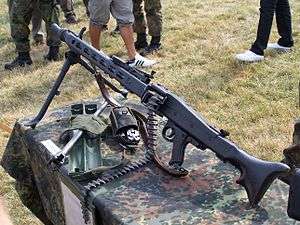Rheinmetall MG 3
| MG 3 | |
|---|---|
|
MG 3 on display | |
| Type | General-purpose machine gun |
| Place of origin | West Germany |
| Service history | |
| In service | 1960–present |
| Used by | See Users |
| Wars |
Iran-Iraq War Turkey-PKK conflict War in Afghanistan Yemeni Civil War (2015)[1] |
| Production history | |
| Designed | 1959 |
| Manufacturer |
Rheinmetall License-built by: Beretta, MKEK, Ellinika Amyntika Systimata, Defense Industries Organization, Military Industry Corporation, Pakistan Ordnance Factories, General Dynamics Santa Bárbara Sistemas |
| Produced | 1960–present |
| Variants | See Variants |
| Specifications | |
| Weight |
10.5 kg (23.15 lb) 27.5 kg (61 lb) (mounted on tripod) |
| Length |
1,225 mm (48.2 in) 1,097 mm (43.2 in) (without stock) |
| Barrel length | 565 mm (22.2 in) |
|
| |
| Cartridge | 7.62×51mm NATO |
| Action | Recoil-operated, roller locked |
| Rate of fire | 1000–1300 rpm[2] |
| Muzzle velocity | 820 m/s (2,690 ft/s) |
| Effective firing range | 200–1,200 m sight adjustments |
| Maximum firing range |
800 m (bipod) 1,000 m (tripod mounted) 3,000 m (gun carriage) |
| Feed system | 50-Round non-disintegrating DM1 belt (can be combined in a drum); 100-Round disintegrating DM6/M13 belt |
| Sights | Open tangent iron sights |
The MG 3 is a German general-purpose machine gun chambered for the 7.62×51mm NATO cartridge. The weapon's design is derived from the World War II era MG 42 universal machine gun that fired the 7.92×57mm Mauser round.[3]
The MG 3 was standardized in the late 1950s and adopted into service with the newly formed Bundeswehr, where it continues to serve to this day as a squad support weapon and a vehicle-mounted machine gun. The weapon and its derivatives have also been acquired by the armed forces of over 30 countries. Production rights to the machine gun were purchased by Italy (MG 42/59), Spain, Pakistan (MG 1A3), Greece, Iran, Sudan and Turkey.[4]
History
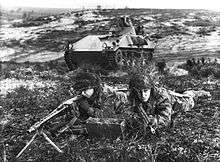
Production of the first postwar variant of the MG 42 chambered in a standard NATO caliber (designated the MG 1) was launched in 1958 at the Rheinmetall arms factory as requested by the Bundeswehr. Shortly thereafter, the machine gun was modified, receiving a chrome-lined barrel and sights properly calibrated for the new round; this model would be named the MG 1A1 (known also as the MG 42/58).
A further development of the MG 1A1 was the MG 1A2 (MG 42/59), which had a heavier bolt (950 g, compared to 550 g), a new friction ring buffer and was adapted to use both the standard German continuous DM1 ammunition belt and the American M13 disintegrating belt. Further improvements to the weapon's muzzle device, bipod and bolt resulted in the MG 1A3.
Simultaneously, wartime 7.92×57mm MG 42 machine guns that remained in service were converted to chamber the standard 7.62×51mm NATO round and designated MG 2.
In 1968, the MG 3 was introduced and entered production. Compared to the MG1A3, the MG 3 features an improved feeding mechanism with a belt retaining pawl to hold the belt up to the gun when the top cover plate is lifted, an added anti-aircraft sight and a new ammunition box. MG 3s were produced for Germany and for export customers by Rheinmetall until 1979. Some additional production of the MG 3 in Germany was carried out by Heckler & Koch.[5] The MG 3 and its variants all share a high level of parts interchangeability with the original MG 42.
Design details
Operating mechanism
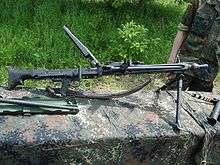
.jpg)
The MG 3 is an automatic, air-cooled, belt-fed short recoil-operated firearm. It features a roller locked bolt mechanism that consists of the bolt head, a pair of rollers, the striker sleeve, bolt body and return spring. The bolt is locked securely by a wedge-shaped striker sleeve, which forces two cylindrical rollers contained in the bolt head outward, and into corresponding recesses in the extension of the breech of the barrel. On firing, both the barrel and barrel extension recoil to the rear. The resulting impact (much like a Newton's cradle) moves the carrier to the rear withdrawing the wedge and both rollers as they are cammed inward and out of their sockets by fixed cams, unlocking the bolt head. The bolt carrier and bolt then continue to the rear together guided by fixed guides while the barrel and barrel extension return to battery. Upon return of the bolt forward, the impact of the rollers against the camming surfaces on the breech carry the rollers from their seats, and, together with the surfaces on the striker sleeve, force the rollers outward, locking the bolt head into the barrel extension and ensuring a complete lock. The bolt also houses a spring-loaded casing extractor and ejector. Ejection is carried out when the ejector strikes the buffer head, sending a push forward through the ejector bar, which hits the ejector pin. This pin pushes the top of the base of the cartridge, which is still held by the extractor at the base, causing the empty casing to rotate and eject downward through the ejection chute.
Features
The machine gun has an automatic-only trigger mechanism and a cross-bolt safety in the form of a button that is operated by the shooting hand (in its "safe" position the bolt release is disabled). The weapon fires from an open bolt. The cyclic rate can be altered by installing different bolts and recoil springs.
The MG 3 feeds from the left side through a feed block using metal, 50-round continuous-link DM1 ammunition belts (which can be combined by cartridge) or disintegrating-link M13 or DM6 belts. In the light machine gun role, the MG 3 is deployed with a 100-round (or 120-round in case of disintegrating belts) belt fitted inside a synthetic ammunition drum developed by Heckler & Koch that is latched on to the left side of the receiver. The rear wall of the drum is transparent and serves as a visual indicator for the amount of ammunition available. The feed system operates through a feed arm that is housed in the feed cover. Two feed pawls are linked to the front end of the arm by an intermediate link and move in opposite directions, moving the belt in two stages as the bolt moves back and forward during firing.
Barrel
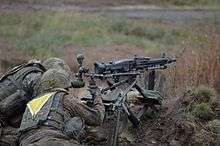
The MG 3 has a quick-change, chrome-lined barrel with four right-hand grooves and a rifling twist rate of 1 in 305 mm (1:12 in). Alternatively, MG 3 barrels can also have polygonal rifling. The barrel is integrated with the barrel breech. During sustained firing, there is a need for the barrel to be changed and this is how they are swapped: The gun is cocked and the barrel catch on the right of the barrel shroud is swung forward. Then, the breech end of the hot barrel swings out and can be removed by elevating or twisting the gun. A fresh barrel would be inserted through the barrel catch and the muzzle bearing. When the catch is rotated back, the barrel is locked and the machine gun can resume firing. Both the receiver housing and ventilated barrel casing are made from pressed sheet steel. A muzzle device is mounted at the end of the barrel and it acts as a flash suppressor, muzzle brake and recoil booster.
The machine gun is equipped with a synthetic polymer stock, a folding bipod and open-type iron sights (sliding rear U-notch on a ramp with range settings from 200 to 1,200 m). A flip-up anti-aircraft sight is also provided.
Feeding
MG3 machine guns are belt-fed, using non-disintegrating metal DM1 belts, which have links that wrap around the cartridge case and are linked by a coiling wire on each side. DM1 belts are preloaded at ammunition factories in 50-round connectable belt lengths and can be linked to any length necessary. Alternatively the MG3 can also be fed by disintegrating metal M13 link belts (designated DM60 by Germany) used by many NATO member states. M13 links are also used on the Dillon M134D Minigun, M60, FN MAG, AA-52 and HK21 machine guns among others. Both belt types use a metal lip that is arrested in the rim of the cartridges to correctly position and fix the cartridges in place. For field use there are several ammunition containers available. The Beltdrum contains a 50-round DM1 or DM60 belt. The steel DM2 ammunition box contains a 250-round DM1 belt and the smaller plastic DM40004 ammunition box contains a 100-round DM1 belt or a 120-round DM60 belt. The German military tends to use non-disintegrating DM1 belts for general use and disintegrating DM60/M13 belts in vehicle or aircraft fixed MG3 mountings that allow for collecting the ejected link pieces for reuse.
Tripod
In a stationary, heavy machine gun role the MG 3 is mounted on a buffered Feldlafette, "field tripod", and outfitted with Zielfernrohr 4 × 24 periscope-style telescopic that like the MG 3 is mounted on the Feldlafette.
Variants
.jpg)
- MG 1: Rheinmetall variant of the MG 42, most notably rechambered to fire 7.62×51mm NATO.
- MG 1A1 (MG 42/58): As MG 1, but with sights properly calibrated for the new round. Sights refitted to existing MG 1s.
- MG 1A2 (MG 42/59): MG 1A1 variant; product improved with longer ejection port, heavy bolt and friction ring buffer.
- MG 1A3: MG 1A2 variant; product improvement of all major components.
- MG 1A4: MG 1 variant; for fixed mount armor use.
- MG 1A5: MG 1A3 variant; MG1A3s converted to MG1A4 standard.
- MG 2: Designation for all wartime MG 42s rechambered to 7.62×51mm NATO.
- MG 3: MG 1A3 variant; product improved with AA rear sight.
- MG 3E: MG 3 variant; reduced weight model (roughly 1.3 kg lighter), entered into late 1970s NATO small arms trials.
- MG 3A1: MG 3 variant; for fixed mount armor use.
- MG 3KWS: MG 3 variant; developed by Rheinmetall and Tactics Group as a stand in until the HK121 replaces it.[6]
- Ksp m/94: Swedish variant chambered with the 7.62×51mm NATO round. Mainly used as secondary armament in Stridsvagn 122.
Multiple barrel variants
A mounted variant with three rotating barrels (to reduce barrel erosion and overheating) is under development as the Rheinmetall RMG 7.62 as a vehicle weapon.
The MG14z is a double barrel variant of the MG 3 machine gun. The MG14z enhances the firepower of military units that still issue the MG 3 or other MG 42 derivatives. It has been developed by the Tactics Group GmbH company "a low-cost alternative to Miniguns".[7][8]
Deployment
The MG 3 is still used as the standard secondary weapon of most modern German armoured fighting vehicle designs (e.g. Leopard 2, PzH 2000, Marder), as a primary weapon on light/non-armored vehicles (e.g. LKW 2to, MAN gl-trucks, ATF Dingo) and as an infantry weapon on light bipods as well as different tripods. However, the German Armed Forces will phase out the MG 3 in 2012; they introduced the HK121 in 2011.
Users

 Albania: Used by the Albanian Army.[9]
Albania: Used by the Albanian Army.[9]-
 Argentina: Used by the Argentine Army.
Argentina: Used by the Argentine Army.  Australia: The MG 3 was used between 1976 and 2007 as an anti-aircraft weapon on the Australian Army's Leopard AS1 MBT.[10]
Australia: The MG 3 was used between 1976 and 2007 as an anti-aircraft weapon on the Australian Army's Leopard AS1 MBT.[10] Austria: Uses the MG 74 which is a MG 42/59 variant licensed from Beretta and manufactured by Steyr Mannlicher. The MG 74's cyclic rate of fire is 850 rounds per minute.[11]
Austria: Uses the MG 74 which is a MG 42/59 variant licensed from Beretta and manufactured by Steyr Mannlicher. The MG 74's cyclic rate of fire is 850 rounds per minute.[11] Azerbaijan: The Military of Azerbaijan acquired a small quantity of MKEK MG 3s from Turkey.
Azerbaijan: The Military of Azerbaijan acquired a small quantity of MKEK MG 3s from Turkey. Bangladesh: Used by the Border Guards Bangladesh [12]
Bangladesh: Used by the Border Guards Bangladesh [12] Brazil: MG3 and MG3A1 are used by the Brazilian Army at the Leopard 1A5 BR.[13]
Brazil: MG3 and MG3A1 are used by the Brazilian Army at the Leopard 1A5 BR.[13] Canada: Only used on 20 Leopard 2A6M CAN tanks acquired from Germany.[14] Leopard 2s acquired from other sources will continue to use the FN MAG.
Canada: Only used on 20 Leopard 2A6M CAN tanks acquired from Germany.[14] Leopard 2s acquired from other sources will continue to use the FN MAG. Cape Verde[15]
Cape Verde[15] Chile[16]
Chile[16] Cyprus:
Cyprus: Denmark: MG 42/59 designated M/62 in Danish service.[17]
Denmark: MG 42/59 designated M/62 in Danish service.[17] Estonia[18] Designated as MG 3. MG 1A3 version with the anti-aircraft sight.
Estonia[18] Designated as MG 3. MG 1A3 version with the anti-aircraft sight. Finland: As the 7.62 KK MG 3. Used with the Leopard 2 tanks and NH90 helicopters.[19]
Finland: As the 7.62 KK MG 3. Used with the Leopard 2 tanks and NH90 helicopters.[19] Germany: Used by the Bundeswehr.[15] A replacement is planned from 2011 onwards.
Germany: Used by the Bundeswehr.[15] A replacement is planned from 2011 onwards. Ghana[20]
Ghana[20] Greece: License production by Hellenic Defense Systems or EAS (formerly Hellenic Arms Industry; Elliniki Biomihania Oplon - EBO).[2][16]
Greece: License production by Hellenic Defense Systems or EAS (formerly Hellenic Arms Industry; Elliniki Biomihania Oplon - EBO).[2][16] Iceland: Used by the Icelandic Coast Guard.[21]
Iceland: Used by the Icelandic Coast Guard.[21] Iran: License production by Defense Industries Organization as the MGA3.[16][22]
Iran: License production by Defense Industries Organization as the MGA3.[16][22] Iraq: Peshmerga of Iraqi Kurdistan autonomous region, 40 supplied by Germany [23]
Iraq: Peshmerga of Iraqi Kurdistan autonomous region, 40 supplied by Germany [23] Italy: License production of the MG 42/59 by Beretta with parts made by Whitehead Motofides and Luigi Franchi; while largely replaced in squad support weapon role by the Belgian FN Minimi, it still sees widespread mounted use on ground-based vehicles and helicopters.[16][24] Prior to the procurement of the Minimi, the Stabilimento Militare Armi Leggere (SMAL) at Terni has developed a kit to adapt the Italian Army's existing MG 42/59 machine guns to accommodate 5.56×45mm NATO ammunition. The kit comprises a new barrel, bolt head, feed opening and cover, recoil-enhancing element and a lighter bolt. The weight of the modified 5.56 mm MG 42/59 machine gun remains unchanged from the original version.
Italy: License production of the MG 42/59 by Beretta with parts made by Whitehead Motofides and Luigi Franchi; while largely replaced in squad support weapon role by the Belgian FN Minimi, it still sees widespread mounted use on ground-based vehicles and helicopters.[16][24] Prior to the procurement of the Minimi, the Stabilimento Militare Armi Leggere (SMAL) at Terni has developed a kit to adapt the Italian Army's existing MG 42/59 machine guns to accommodate 5.56×45mm NATO ammunition. The kit comprises a new barrel, bolt head, feed opening and cover, recoil-enhancing element and a lighter bolt. The weight of the modified 5.56 mm MG 42/59 machine gun remains unchanged from the original version. Latvia: Latvian Land Forces
Latvia: Latvian Land Forces Lithuania: Lithuanian Armed Forces.[25]
Lithuania: Lithuanian Armed Forces.[25] Mexico: License produced by SEDENA in Mexico.[26]
Mexico: License produced by SEDENA in Mexico.[26] Myanmar[15]
Myanmar[15] Norway[15]
Norway[15] Pakistan: Used by the Pakistan Army.[27] Manufactured under license by Pakistan Ordnance Factories in Wah Cantt.[28]
Pakistan: Used by the Pakistan Army.[27] Manufactured under license by Pakistan Ordnance Factories in Wah Cantt.[28] Poland: On Leopard 2 tanks and support vehicles. Probably to replace by UKM-2000 and WKM-B.[29]
Poland: On Leopard 2 tanks and support vehicles. Probably to replace by UKM-2000 and WKM-B.[29] Portugal[16]
Portugal[16]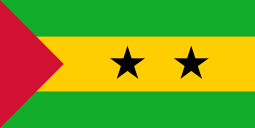 Sao Tome and Principe[15]
Sao Tome and Principe[15] Saudi Arabia[15]
Saudi Arabia[15] Spain: Made under license.[16]
Spain: Made under license.[16] Sudan: Made by Military Industry Corporation as the Karar.[30]
Sudan: Made by Military Industry Corporation as the Karar.[30] Sweden: As the KSP m/94. Used with the Leopard 2 tanks.[31]
Sweden: As the KSP m/94. Used with the Leopard 2 tanks.[31] Thailand: Used on Commando V-150 APC.
Thailand: Used on Commando V-150 APC. Togo[15]
Togo[15] Turkey: Made by MKEK in Kırıkkale under license since 1974[32] for the Turkish Armed Forces and Turkish Gendarmerie.[33]
Turkey: Made by MKEK in Kırıkkale under license since 1974[32] for the Turkish Armed Forces and Turkish Gendarmerie.[33]- ISIL
See also
- General-purpose machine gun
- FN MAG 7.62mm (NATO) general-purpose machine gun.
- Heckler & Koch HK121 7.62mm (NATO) general-purpose machine gun.
- MG51 7.5×55mm (Swiss) general-purpose machine gun.
- SIG 710-3, Swiss derivative of MG 42.
Notes
- ↑ Dnevnik (in Slovenian). Ljubljana, Slovenia: Radiotelevizija Slovenija. 2015. Event occurs at 17:13. Retrieved 8 August 2015.
- 1 2 "Hellenic Defense Systems". Eas.gr. 2013-07-31. Retrieved 2014-02-09.
- ↑ Woźniak, Ryszard: Encyklopedia najnowszej broni palnej—tom 3 M-P, page 106. Bellona, 2001.
- ↑ "MKEK - PRODUCT DETAILS". web.archive.org. Retrieved 2014-04-04.
- ↑ Shepherd, Christian. "Machine Gun 42". Tactical Life. Retrieved 2014-02-09.
- ↑ Steve, Johnson. "Bundeswehr MG3KWS Upgrade Program". The Firearm Blog. Retrieved 2014-01-19.
- ↑ "Tactics Group MG-14z - Trade Shows 2014 - IWA 2014 - all4shooters.com". all4shooters.com. Retrieved 2014-06-28.
- ↑ "Двуствольный пулемет Tactics Group MG-14z » Военное обозрение". topwar.ru. Retrieved 2014-06-28.
- ↑ http://www.armyrecognition.com/almex_2011_daily_news_albania_defence_exhibition/the_45_albanian_army_special_forces_face-to-face_with_the_taliban_s_in_kandahar_afghanistan.html
- ↑ "Leopard AS1 Main Battle Tank Part One by Paul D. Handel". Retrieved 2014-01-11.
- ↑ "Österreichs Bundesheer - Waffen und Gerät - Maschinengewehr MG 74". Bmlv.gv.at. Retrieved 2014-02-09.
- ↑ "Bangladesh Military Forces | The internet's authority on Bangladesh Defence and Bangladesh Armed Forces". Bdmilitary.com. Retrieved 2014-02-09.
- ↑ Archived June 1, 2010, at the Wayback Machine.
- ↑ "An error has occurred in Portfolio NetPublish". combatcamera.forces.gc.ca. Retrieved 2014-04-04.
- 1 2 3 4 5 6 7 Jones, Richard D.; Ness, Leland S., eds. (January 27, 2009). Jane's Infantry Weapons 2009/2010 (35th ed.). Coulsdon: Jane's Information Group. ISBN 978-0-7106-2869-5.
- 1 2 3 4 5 6 "G3 Defence Magazine August 2010". En.calameo.com. 2010-08-04. Retrieved 2014-02-09.
- ↑
- ↑ "Uudised - Kaitsevägi". Mil.ee. Retrieved 2014-02-09.
- ↑ "Puolustusvoimat" (in Finnish). Mil.fi. Retrieved 2014-02-09.
- ↑ "Ghanaian army Sgt. directs his men forward". Militaryimages.net. Retrieved 2014-01-11.
- ↑ "Hátt í 400 hríðskotabyssur í landinu.". RÚV. Retrieved 2014-10-27.
- ↑ Archived October 30, 2008, at the Wayback Machine.
- ↑ http://www.bild.de/politik/inland/isis/diese-waffen-liefert-deutschland-an-die-kurden-37478284.bild.html
- ↑ Archived May 20, 2011, at the Wayback Machine.
- ↑ (Lithuanian) Lietuvos kariuomenė :: Ginkluotė ir karinė technika » Kulkosvaidžiai » Kulkosvaidis MG-3. Kariuomene.kam.lt (2009-04-17). Retrieved on 2010-10-18.
- ↑ "Mexico Mexican army land ground forces military equipment armoured vehicle pictures information desc - Army Recognition". Retrieved 2014-01-11.
- ↑ "Pakistan Army". Defence.pk. Archived from the original on 2013-05-13. Retrieved 2014-02-09.
- ↑ "POF - Machine Gun MG3 (MG1A3)". Pof.gov.pk. Retrieved 2014-02-09.
- ↑
- ↑ Archived March 10, 2008, at the Wayback Machine.
- ↑ Henrik Svensk. "Strv122 Stridsvagn 122 Leopard 2". Soldf.com. Retrieved 2014-02-09.
- ↑ Archived February 10, 2012, at the Wayback Machine.
- ↑ Archived April 14, 2009, at the Wayback Machine.
References
- Ezell, Edward C. (1988). Small Arms Today 2nd Edition. Harrisburg, PA: Stackpole Books.
- Woźniak, Ryszard (2001). Encyklopedia najnowszej broni palnej—tom 3 M-P (in Polish). Warsaw, Poland: Bellona. ISBN 83-11-09311-3.
External links
| Wikimedia Commons has media related to MG3. |
- Bimbel.de—MG3 disassembled
- Bimbel.de—MG3 on mount
- MG 3 video
- Machine Gun MG3 (MG1A3)
- 7.62 mm MG3 MACHINE GUN
